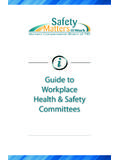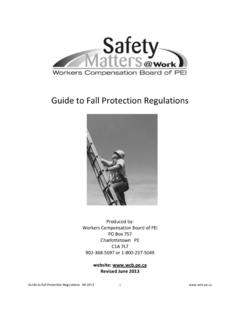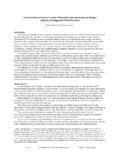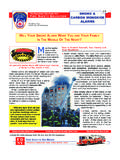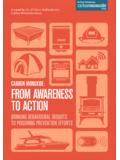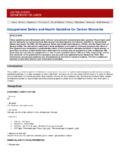Transcription of &DUERQ 0RQR[LGH Hazard Alert - WCB
1 Alert HazardHazardHazard carbon monoxide To report a serious workplace incident or Hazard , call the 24hr OHS Emergency Line at 902-628-7513 A worker was exposed to high levels of carbon monoxide while repairing a refrigeration unit in a small walk-in freezer. The refrigeration coil was completely encased in ice and the worker used an acetylene torch to melt the ice before the repairs could begin. The worker began exhibiting signs of acute carbon monoxide exposure such as headache, nausea, confusion and a period of unconsciousness. Fortunately when it was reported that the worker wasn t feeling well, 911 was called and he received immediate assistance. When the physician determined that the level of carboxyhemoglobin (COHb) was greatly elevated, the exposed worker was transported to a hospital in Halifax to be treated in a hyperbaric chamber. The attending physician reported that the oxygen levels in the worker s blood were so low that this incident was very close to being a fatality.
2 After six hours of hyperbaric oxygen therapy, however, the worker recovered from the carbon monoxide poisoning. Hazard SUMMARY carbon monoxide can be dangerous in areas where there is incomplete burning of carbon -containing materials, such as gasoline, oil, propane, acetylene, coal or wood. The risk becomes much greater in an area where there is poor or no ventilation. Workplaces where carbon monoxide poisoning is a serious risk include those that have sources of any of the following emissions: Vehicles, Portable generators, Gas-powered tools, Propane space heaters, Furnaces and boilers, and WeldingHAZARD LOCATION Figure 1 Frozen Refrigerator Coil CAUSE The incomplete combustion of the acetylene gas caused carbon monoxide to be released. This was directly inhaled by the worker. carbon monoxide is known as a silent killer because it is a colourless, odourless, tasteless poisonous gas. It is harmful when inhaled because it displaces oxygen in the blood and deprives the heart, brain and other vital organs of oxygen.
3 Figure 2 Acetylene Torch Visit the Workers Compensation Board website at or contact the WCB Occupational Health & Safety Division at 902-368-5680 or 1-800-237-5049 (Toll free in Atlantic Canada). FOR MORE INFORMATIONTo report a serious workplace incident or Hazard , call the 24hr OHS Emergency Line at 902-628-7513 RECOMMENDED PRECAUTIONS Educate workers on the symptoms of carbon monoxide poisoning and the importance of getting medicalassistance immediately. Inform workers of working alone procedures to ensure that they are in contact with someone who canprovide assistance in hazardous situations. Recognize potential ventilation problems in enclosed areas where gases of burning fuels may be released. Use alternative equipment powered by electricity or batteries if possible when working in enclosedspaces. Wear personal carbon monoxide monitors with audible alarms if potential exposure to carbon monoxideexists. Use appropriate respirator or breathing apparatus depending on the workplace conditions, the carbonmonoxide levels, and the amount of time spent in the hazardous environment.
4 Ensure workers are adequately trained to properly use respirators, have been fit-tested, and are clean-shaven before REQUIREMENTS Section of the Occupational Health and Safety (OHS) Regulations states that where the air ofworking areas is contaminated by vapours, fumes, gases, mists or other impurities which constitute ahazard to the health or safety of employees, suitable means of ventilation shall be provided by theemployer to reduce contamination in the atmosphere at or below the Threshold Limit Values, known as TLV s, as prescribed by the American Conference of Governmental Industrial Hygienists (ACGIH). Section (2) of the OHS Regulations states that every employer shall ensure that where theprevention or elimination of such hazardous conditions is not reasonably practicable, or where theexposure results from temporary or emergency conditions only, every employee exposed shall wearapproved protective respiratory equipment.
5 Section (1) of the OHS Regulations state that where a worker is working alone, the employer shalldevelop and implement written procedures to ensure, as far as is reasonably practicable, the health andsafety of the worker from risks arising out of, or in connection with, the work assigned.


